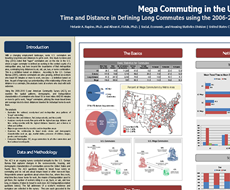Mega Commuting in the U.S.
Mega Commuting in the U.S.
Introduction
With a changing employment landscape, some U.S. commuters are travelling long times and distances to get to work. One study by Moss and Qing (2012) noted that “super” commuters are on the rise in the U.S. In their analysis, a super commuter is defined as working in the central county of a metropolitan area, but lives beyond the boundaries of that metropolitan area, commuting long distances by air, rail, car, bus, or some combination. This is a definition based on distance. Extreme commuting has been increasing since at least 1990 (see Figure 1). Extreme commuters are defined as workers who travel 90 minutes or more to work, one-way – a definition based on time (U.S. Census Bureau, 2005). Additionally, this research defines long-distance commuters as workers who travel 50 miles or more to work, one-way. And mega commuters as those who combine these two definitions and travel 90 minutes or more and 50 miles or more to work, one-way.
Others in Series
Working Paper
Working Paper
Working Paper





